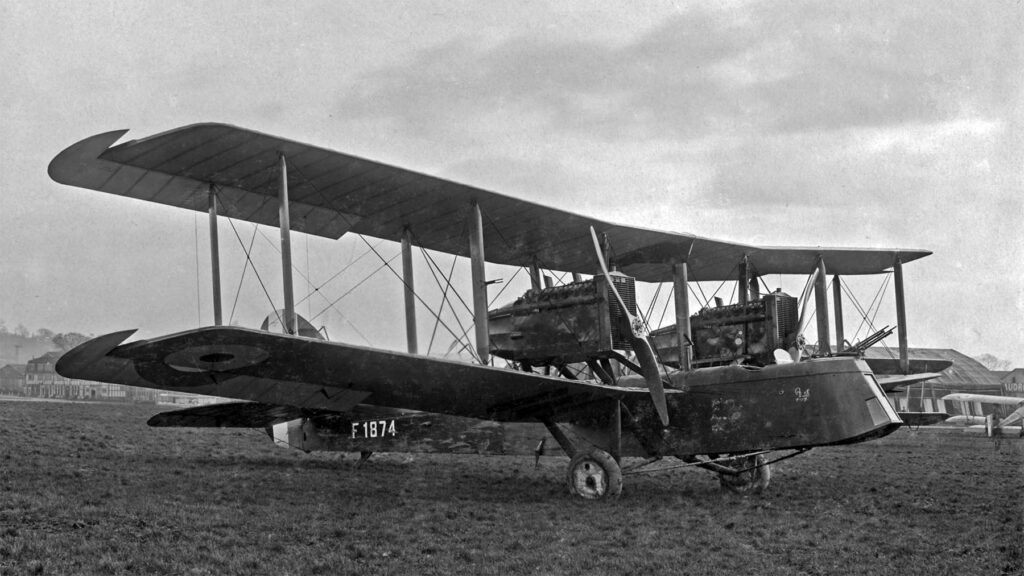Airco DH.10: An early bomber, twin-engine biplane with a significant payload and range, crucial to WWI’s late aerial campaigns. The Airco DH.10 Amiens was an influential British twin-engine biplane bomber developed during World War I. It was designed to meet the need for a long-range bomber capable of reaching distant targets. The DH.10 boasted significant advancements in payload and range, although it saw limited action due to its late entry into the war. Its design principles and operational experience influenced future multi-engine aircraft development.
The introduction of the Airco DH.10 Amiens marked a transitional period in military aviation, showcasing the shift towards multi-engine bombers capable of long-range missions. As warfare evolved, so did the requirements for aircraft that could deliver heavier payloads over extended distances.
History of the Development of the Airco DH.10 Amiens
During the latter stages of World War I, the British Royal Flying Corps (later Royal Air Force) recognized the need for a long-range bomber that could penetrate deep into enemy territory. Traditional bombers were insufficient in range and payload, necessitating the development of a more capable aircraft.
Under the design guidance of Geoffrey de Havilland, the Airco DH.10 was developed by the Aircraft Manufacturing Company (Airco). The objective was clear: create a bomber that could carry a substantial payload over considerable distances, thereby enhancing the RAF’s strategic bombing capabilities.
The development program was launched amid the tumultuous climate of 1917, with the urgency imposed by the relentless progression of the war. The first prototype took to the skies in March 1918, representing a significant leap in bomber design.
Design of the Airco DH.10 Amiens
The DH.10 Amiens was a significant design advancement, integrating twin engines—a rarity at the time—and embodying the biplane configuration. It measured 42 feet 4 inches (12.9 meters) in length, with a wingspan of 65 feet 6 inches (19.96 meters), and was constructed with a wooden frame and fabric covering.
One of the design’s primary advantages was its ability to house two Rolls-Royce Eagle VIII engines, each producing 360 horsepower. This twin-engine configuration provided redundancy and increased reliability—essential for long-range missions.
The bomber’s internal structure allowed for a substantial bomb load, accommodating up to 1,540 pounds (700 kilograms) of munitions. However, its size and complexity presented drawbacks, including more challenging maintenance and production difficulties. Despite these challenges, the design of the DH.10 laid the groundwork for future multi-engine aircraft.

Performance of the Airco DH.10 Amiens
The DH.10 Amiens’ performance was a marked improvement over its single-engine predecessors. With a top speed of 123 mph (198 km/h), it could reach a service ceiling of 16,500 feet (5,030 meters) and had a range of 1,350 miles (2,173 kilometers)—remarkable for its time.
When compared to other bombers of the era, such as the Handley Page O/400, the DH.10 featured better speed and range, though it carried a slightly smaller payload. Its twin-engine design provided a level of safety and performance that few contemporary aircraft could match.
Military Use and Combat of the Airco DH.10 Amiens
The DH.10 was armed with two .303 inch Lewis guns for defense and carried its bomb load in an internal bay. It was designed to perform strategic bombing missions over continental Europe, a task it undertook in the closing months of the war.
Despite its late entry into service, with No. 104 Squadron RAF becoming operational in September 1918, the DH.10 participated in several key operations. It was a capable bomber, but its impact was limited by the war’s end.
Competing aircraft of the time included the aforementioned Handley Page O/400 and the German Gotha bombers. While it did not serve in vast numbers, the DH.10 influenced several post-war designs and military doctrines.
After the war, the DH.10s were sold to other countries, including the United States and India. Its military use was short-lived, as it was replaced by more advanced designs in the subsequent years, such as the Vickers Vimy.
The Airco DH.10 Amiens played a brief but pivotal role in the evolution of military aviation. It pushed the boundaries of what was possible with bomber design during the First World War and set a precedent for future multi-engine aircraft. Although its operational history was limited, the DH.10’s advancements in range, payload, and reliability paved the way for the next generation of strategic bombers.
Back to the Bombers section.